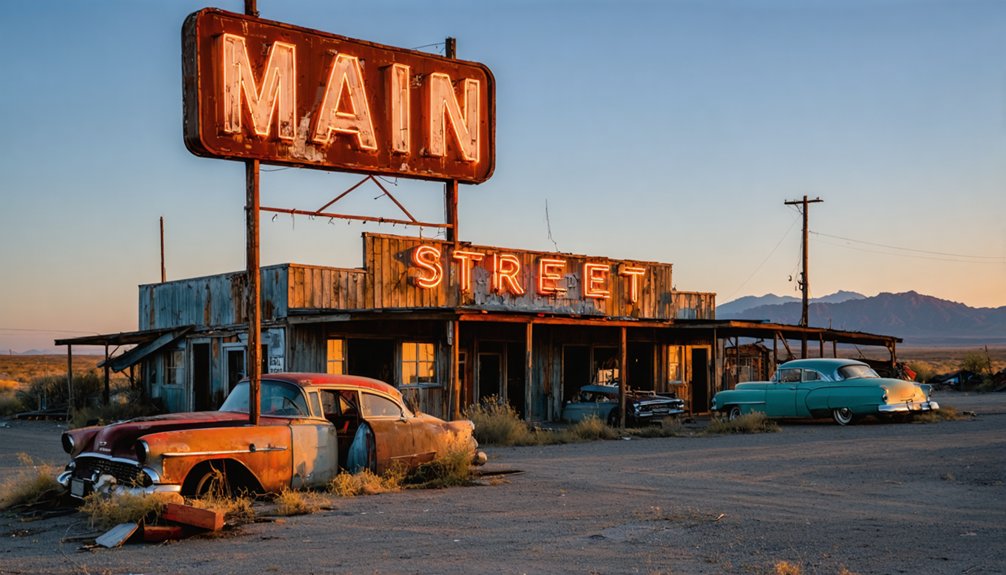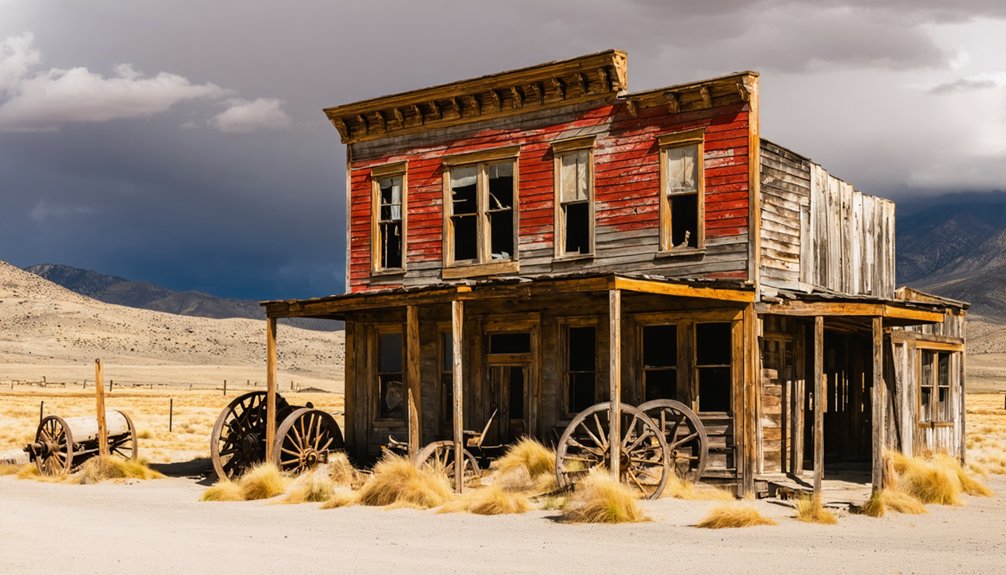You’ll find abandoned settlements across the world, from radiation-frozen Pripyat to sand-swallowed Kolmanskop and America’s weathered Gold Rush towns. These places stand as eerie time capsules where nature slowly reclaims human ambition. China’s modern ghost metropolises present a contemporary twist with empty skyscrapers and plummeting property values. Each decaying structure tells a story of prosperity, disaster, and sudden exodus that whispers its secrets to those who dare explore.
Key Takeaways
- Abandoned ghost towns like Bodie preserve over 100 structures in “arrested decay,” showcasing the fleeting nature of gold rush prosperity.
- Pripyat, Ukraine stands frozen in time with its iconic unridden Ferris wheel following the 1986 Chernobyl disaster evacuation.
- Kolmanskop’s grand German mansions in Namibia are now half-buried by desert sands, creating surreal landscapes of nature reclaiming human settlement.
- The Island of Dolls and India’s Bhangarh Fort represent spiritually haunted abandoned locations with disturbing histories and paranormal reputations.
- Ghost towns often leave behind toxic environmental legacies from mining operations, requiring decades of remediation efforts.
The Haunting Silence of Pripyat: Ukraine’s Nuclear Ghost City
What remains when an entire city is abandoned in the blink of an eye? In Pripyat, you’ll find the haunting answer. Founded in 1970 as a model Soviet atomgrad, this once-thriving community of 50,000 was evacuated just 36 hours after the Chernobyl disaster on April 26, 1986.
As you wander through its decaying streets, Chernobyl memories echo in every building. The iconic Ferris wheel, frozen in time, never had its grand opening. The area became one of the strictly regulated closed zones due to severe radiation contamination. Average radiation levels remain several times higher than normal background readings, with numerous dangerous hotspots throughout the region.
Soviet modernist apartment blocks stand like silent sentinels while nature reclaims what humans left behind. Urban decay tells stories of lives interrupted—schoolbooks still open on desks, personal belongings gathering dust for decades.
Time stands still while the forest marches forward, claiming concrete monuments to vanished lives.
Today, this ghost city draws dark tourists seeking both adventure and sobering reflection on nuclear power’s dangers.
Hashima Island: Japan’s Decaying Concrete Fortress
Rising from the turbulent waters of the East China Sea, Hashima Island stands as a decaying monument to Japan’s industrial past.
You’ll witness the remnants of Japan’s first reinforced concrete apartments, built to withstand typhoons while housing over 5,000 residents in one of Earth’s densest communities.
Hashima’s history began in 1810 with coal discovery, but Mitsubishi’s 1890 acquisition transformed it into an industrial powerhouse.
By 1941, its mines yielded 410,000 tons annually, fueling Japan’s military and economic ambitions.
The island’s urban infrastructure once included schools, hospitals, and entertainment—a complete concrete city at sea. Daily life revolved around a self-contained ecosystem where residents formed strong community bonds despite the harsh conditions. Visitors can see the ruins of Hashima Elementary and Junior High School, established in 1927 and completed in 1958 for educating hundreds of coal miners’ children.
Behind this engineering marvel lies darkness: Korean and Chinese forced laborers toiled in deadly conditions during WWII.
Today, as a UNESCO site, Hashima’s crumbling structures tell both tales of innovation and human suffering.
Kolmanskop: Where Desert Sands Reclaim Human Ambition
Deep in the shifting sands of Namibia’s coastal desert, the ghost town of Kolmanskop tells a tale of fleeting prosperity and nature’s relentless reclamation.
You’ll walk through grand German-style mansions now half-swallowed by dunes, where diamond mining once fueled unimaginable luxury.
Discover rooms where sand pours through windows like liquid gold, filling spaces where miners once celebrated their fortunes with ice-cooled drinks and bowling matches.
Time flows like sand through these forgotten halls, wealth and revelry buried beneath the dunes’ golden embrace.
Abandoned in 1956 after richer diamond deposits were found in Oranjemund, Kolmanskop now stands frozen in time.
Desert encroachment transforms once-opulent homes into surreal landscapes of sand waves crashing against peeling wallpaper.
As you explore this protected tourist site, you’ll witness nature’s patient victory over human ambition—a haunting reminder that even our grandest achievements ultimately bow to time and elements.
The town reached its pinnacle of wealth during the early 1920s when diamond mining operations were at their height.
At its peak, this remarkable settlement boasted 12% of global diamonds and became one of the wealthiest places on earth.
America’s Forgotten Gold Rush Towns
You’ll discover a pattern of overnight prosperity and sudden abandonment as you wander through America’s gold rush ghost towns, where tens of thousands once scrambled for fortune before vanishing when the precious ore played out.
Stand among weathered wooden storefronts and Victorian-era structures in places like Bodie or Bannack, where each creaking floorboard tells stories of lawless saloons, vigilante justice, and desperate prospectors. These deserted towns began with Spanish miners in the late 1600s before the California gold rush ignited widespread mining across the western frontier.
These preserved architectural time capsules stretch across California, Nevada, Montana, and Colorado, revealing the brief, tumultuous chapter when gold fever transformed empty landscapes into bustling cities before nature reclaimed them. The WikiProject Ghost Towns initiative aims to improve Wikipedia’s coverage of these historical sites by establishing clear notability criteria for associated individuals and companies.
Boomtown Bust Patterns
As the dust settles on America’s golden dreams, the remnants of once-thriving boomtowns dot the western landscape like skeletal monuments to fleeting fortune.
You’ll find these abandoned settlements followed predictable gold rush dynamics—explosive growth followed by inevitable collapse when the precious ore dwindled.
In their heyday, these towns burst with thousands of fortune-seekers, boasting saloons, newspapers, and railroads.
Places like Bodie, California produced a staggering $35 million in gold before fading away. The approximately 110 structures still standing today serve as a preserved testament to its former glory.
The fragile nature of mining sustainability became painfully evident as environmental degradation, external disruptions like world wars, and depleted resources triggered their downfall.
Towns like Rhyolite, Nevada experienced dramatic population crashes, declining from thousands of residents to fewer than 700 in just a few short years.
Within decades of their founding, most boomtowns emptied as quickly as they’d filled, leaving behind weathered wooden structures in “arrested decay”—silent testimonies to America’s brief, brilliant gold fever.
Lawless Mining Communities
Beyond the economic booms and busts that defined these forgotten outposts, a more volatile reality shaped their brief existence.
You’d find yourself maneuvering through settlements like Deadwood and Jerome, where saloons and brothels operated alongside deadly gunfights and robberies.
Without effective law enforcement, communities established miners’ courts where local juries dispensed swift frontier justice.
When even these proved insufficient, vigilante justice emerged—hangings and deportations became commonplace methods for maintaining order.
Walking these dusty streets meant navigating deep ethnic tensions.
Civil War loyalties divided neighbors, while Chinese miners faced brutal exclusion.
Violence simmered between wealthy mine owners and struggling laborers, creating a powder keg atmosphere.
These weren’t merely places of economic opportunity—they were crucibles where desperation, ambition, and survival instincts collided in America’s unforgiving frontier experiment.
Preserved Western Architecture
While fortune-seekers have long since departed, the architectural legacy of America’s gold rush towns stands as a tribute to their fleeting magnificence.
You’ll discover remarkably preserved structures throughout the western frontier, from Nevada City’s 90+ Gold Rush-era buildings to Virginia City’s wealth-driven landmarks.
Wander these living museums where architectural history breathes through:
- St. Elmo’s wooden sidewalks and operational general store, frozen in 1880s splendor
- Grass Valley’s Empire Mine complex, where Cornish influence shapes brick buildings downtown
- Nevada City’s National Historic Landmark district featuring 70+ structures dating from 1856
- Coloma’s historic Sutter’s Mill site, where a single discovery changed America forever
Step into these time capsules where gold fever’s architectural ambitions remain intact, inviting you to experience the unbridled optimism of America’s most adventurous era.
China’s Empty Metropolises: Modern Ghost Cities
If you travel to China’s ghost metropolises, you’ll encounter vast cityscapes of gleaming skyscrapers and wide boulevards where your footsteps echo in eerie silence.
These modern phantom cities represent over $2 trillion in development investments, with enough empty housing units to shelter the entire population of France, standing as monuments to ambitious planning divorced from reality.
The sprawling districts of Ordos Kangbashi and Tianducheng—complete with their own Eiffel Tower replica—offer you surreal journeys through fully-built urban landscapes where traffic lights change for non-existent traffic and shopping malls remain pristinely empty.
Massive Empty Investments
Beneath the gleaming skyscrapers and wide boulevards of modern China lies a peculiar phenomenon that’ll leave you feeling like you’ve stepped into an alternate reality—entire cities built for millions where almost no one lives.
These massive empty investments represent one of history’s greatest urban decay experiments, with property values plummeting by up to 95% in some ghost metropolises.
You’re witnessing the aftermath of economic ambition untethered from reality:
- Over 50 officially recognized empty cities dot the landscape, housing enough vacant units for France’s entire population
- Local governments prioritized construction over actual demand, creating metropolises with no inhabitants
- Since 2020, 77 property developers have defaulted on debts as the bubble bursts
- Some areas, like Pudong, eventually transform from ghostly to thriving—proof that freedom from central planning matters
Eerie Uninhabited Architecture
Standing amid the silent boulevards of China’s ghost metropolises, you’ll encounter a haunting tableau of architectural ambition frozen in time. Sleek skyscrapers rise majestically alongside extravagant monuments, yet darkness pervades where lights should flicker with life.
Places like Tianducheng with its Parisian-inspired design and Thames Town’s British architecture create eerie landscapes where your footsteps echo unnervingly. These vacant structures—built for millions but housing mere thousands—tell tales of hasty development outpacing actual demand.
In Chenggong, you’ll find demolished buildings where dreams crumbled, while Kangbashi gradually evolves from emptiness to liveliness. Half-finished infrastructure deteriorates in these modern ruins, creating an atmosphere both melancholic and fascinating.
Here, China’s urban planning aspirations stand suspended—concrete monuments to speculative investment rather than human habitation.
The Island of Dolls: Mexico’s Macabre Abandoned Shrine

Deep in the labyrinthine canals of Xochimilco, south of Mexico City, lies one of the world’s most unnerving abandoned places—the Island of Dolls.
Created by Don Julián Santana Barrera in the 1950s, this chinampa’s doll origins stem from his discovery of a drowned girl’s body nearby. To appease her restless spirit, he began hanging dolls throughout the island, creating a macabre shrine that continues to grow even after his death in 2001.
The island’s caretaker created this haunting collection after finding a drowned child, believing dolls would appease her wandering spirit.
As you float toward this eerie destination on a traditional trajinera, you’ll encounter:
- Thousands of weather-worn dolls with missing limbs and hollow eyes that seemingly follow your movements
- Whispers and unexplained sounds that intensify at night
- The haunted legends of dolls that move on their own
- Don Julián’s abandoned hut, where his ghost reportedly still wanders
Bhangarh Fort: India’s Officially Haunted Destination
Among India’s most mysterious and forbidding ruins, Bhangarh Fort rises from the foothills of the Aravalli range like a warning etched in stone. Built in the 17th century by Madho Singh, this abandoned stronghold carries the weight of haunted legends that have outlived its inhabitants.
You’ll find official government warnings prohibiting visits after sunset—unique restrictions that fuel its reputation as India’s most haunted destination. The curse of Baba Balau Nath still echoes through crumbling walls, while the vengeful wizard’s spell lingers in the air.
Paranormal investigations have documented unexplained sounds and apparitions throughout the complex. During daylight, you’re free to explore its architectural splendor, but as shadows lengthen, locals warn you to depart—for after dark, the fort reclaims its secrets.
The Environmental Aftermath of Abandoned Settlements

While ghosts may haunt the corridors of abandoned fortresses, a more tangible specter looms over deserted settlements worldwide—environmental devastation that persists long after human inhabitants have fled.
You’ll encounter these toxic legacies as you explore forgotten places:
- Waterways poisoned by acid mine drainage, carrying arsenic and mercury for miles downstream
- Landscapes scarred by collapsed mine shafts, creating dangerous sinkholes where solid ground once stood
- Ghost town air that still carries dust from industrial remnants, visible in shafts of sunlight
- Wildlife struggling to return to these contaminated ecosystems, often mutated by chemical exposure
Environmental remediation of these sites requires decades of commitment and contamination monitoring, yet many abandoned settlements remain untouched—toxic time capsules slowly leaking their poisons into the surrounding wilderness.
Frequently Asked Questions
Can You Legally Live in an Abandoned Ghost Town?
You can’t legally establish residency without acquiring property rights first. Ghost towns carry serious legal implications—you’ll need permits, ownership verification, and compliance with local residency requirements before settling in.
Why Don’t Governments Repurpose Ghost Cities Instead of Abandoning Them?
You’re witnessing the harsh reality—governments can’t justify urban revitalization when economic feasibility isn’t there. Remote locations, crumbling infrastructure, and legal tangles make these weathered skeletons too costly to resurrect.
Are There Any Successfully Revitalized Former Ghost Towns?
You’ll find remarkable revitalization success stories like Jerome, Arizona and Bodie, California, where passionate community engagement transformed desolate ruins into vibrant cultural hubs that beckon adventure-seekers to their historic streets.
What Health Risks Exist When Visiting Radioactive Abandoned Areas?
Like moths drawn to deadly flames, you’ll face radiation exposure risks including cancer, genetic damage, and radiation sickness. Always carry a Geiger counter and follow safety precautions to safeguard your adventurous spirit.
How Do Researchers Document Ghost Towns Before They Completely Deteriorate?
You’ll find researchers capturing ghost towns’ fading glory through extensive photographic surveys, drone footage, and 3D modeling, while digging into historical records to preserve the stories before time claims these forgotten places forever.
References
- https://vocal.media/writers/6-countries-with-the-most-deserted-cities-in-the-world-913460dpg
- https://www.businessinsider.com/eeriest-things-seen-while-exploring-abandoned-ghost-towns-2022-10
- https://en.wikipedia.org/wiki/List_of_ghost_towns_by_country
- https://www.youtube.com/watch?v=VC1d0w8KxMw
- https://www.losethemap.com/scariest-ghost-towns-in-the-world/
- https://www.youtube.com/watch?v=0fwH0c-delI
- https://worldpopulationreview.com/world-city-rankings/abandoned-cities
- https://www.geotab.com/ghost-towns/
- https://www.guinnessworldrecords.com/news/2025/9/the-ghost-towns-at-the-edge-of-the-world-that-broke-record-titles-without-people
- https://en.wikipedia.org/wiki/Ghost_town



